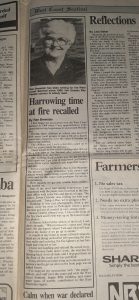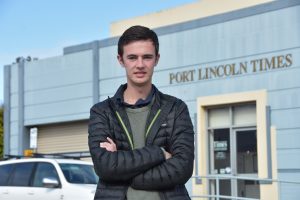By Royce Kurmelovs
Rae Brewster was 36-years-old when a past editor of the West Coast Sentinel asked if she wanted to contribute to the paper as a correspondent.
She lived in Streaky Bay, a small community of 1300 people living on an idyllic strip of coastline, eight-hours west of Adelaide. Brewster, now 91, says her main qualification for the role was her deep involvement in “everything”.
“It didn’t matter what club, I was involved in everything,” she says. “When you’re in a remote community, you always help out. It doesn’t matter whether you get paid, or you don’t.”
The paper paid 20 cents an inch for news and she worked from home where she wrote up births, deaths and marriages for the paper over the next 25 years. In that time, she tallied money raised by charity events, chronicled the adventures of those who travelled overseas and wrote a column titled “About People”.
Her most dramatic story involved a diver trapped beneath the surface by a circling shark with his oxygen running low. Her biggest – a report on a mini-cyclone that hit the town – took the front page. Brewster personally counted the 42 television antennas it knocked out of action.
“The news keeps people in regional areas together,” she says. “It’s the story of us.”
The world has changed considerably since Brewster was working as a correspondent but perhaps one of the biggest was the closure of her old paper The West Coat Sentinel, which was shuttered along with the Eyre Peninsula Tribune.
These losses were part of a string of closures across regional areas around Australia, leading to tense warnings about the potential for “news deserts” – an imperfect term to describe the information vacuum left when crucial news organisations within a community close.
However, a recent report by the Public Interest Journalism Initiative (PIJI) found print news in the Eyre Peninsula has bucked the trend among other regional areas with its extraordinary resilience.
A “marvellous” recovery
PIJI researchers sought to understand not only which news organisations were still serving an audience of 30,000 people, but what they were doing with their coverage.
To help them find out they sampled the entire news output of all print and online news publishers on the peninsula – an area sprawling 170,500km2 and ten local government areas – during the month of February 2023.
The researchers reviewed a total 394 stories published by five publications: the ABC Eyre Peninsula, ABC North and West SA, Eyre Peninsula Advocate, The Port Lincoln News and The Port Lincoln Times.
Print and radio broadcasts were not included in the sample due to difficulty in obtaining reliable transcripts. They also excluded Whyalla, as the city formed a separate media market for historical, cultural and demographic reasons.
Head of Research at PIJI, Gary Dickson, who led the project, says the results reveal a media environment that was successfully delivering high quality public interest reporting on local government, sport, community matters and public services.
Of the news providers, the two major papers – The Port Lincoln Times and start-up paper The Eyre Peninsula Advocate – provided strong coverage from right across the region.
“It was quite impressive, actually,” Dickson says.
“They covered meaningful amounts from every local government area across the month and when you consider how remote, and how small the populations are in some of these local government areas, I think that is a really impressive feat.
“We certainly see places that are less remote get less coverage.”
Court reporting was the weakest area of coverage but Dickson says this is not unusual for regional news organisations as assigning reporters to the beat was a significant investment in resources, particularly when working across a wide geographic area.
Dr Kathryn Bowd, a senior lecturer in the Department of Media at the University of Adelaide who studies regional media and was not involved in PIJI’s study, says the result is “surprising and marvellous”.
“The results surprised me because I didn’t expect things to look as good as they do,” Dr Bowd says.
She says it shows the demand for local news in regional areas remains strong.
“The take-home message is that local news is no less important now than it has ever been, despite all the changes in the media market,” she says.
“It’s really evident that local people want local news.”
Local flourish
The conclusions of the PIJI report provide a sense of how regional media on the Eyre Peninsula is rebounding, despite questions being asked about its future during the opening stages of the pandemic.
As the world retreated, tourism collapsed and events were cancelled, causing advertising revenue to evaporate among many mastheads. On the Eyre Peninsula, as elsewhere, Australian Community Media (ACM) responded by closing its regional news newsrooms.
The result was a vacuum. Regional television news outfit, Southern Cross News, helped fill the gap although its focus was primarily on Port Lincoln and not the wider region. That station has also recently closed down.
“There wasn’t as much news in areas outside of the lower Eyre Peninsula,” Luca Cetta says. “Personally, being part of it, it was a difficult time. People were asking me all the time: ‘when’s The Sentinel coming back? What’s happening?’ They certainly missed it when it was gone.”
Cetta is the editor of both The Port Lincoln Times and The Eyre Peninsula Advocate. Though they are separate mastheads, they are produced by the one team which was merged in April 2023 after media company SAToday bought both papers.
Now it is staffed by three reporters stationed at their Port Lincoln Newsroom, a reporter covering Cleave and the surrounding area from the eastern Eyre Peninsula, freelancers in Streaky Bay and Lach, and Cetta himself reporting from Ceduna.
Since the merger, they have also worked to ensure both print mastheads remain distinct “where possible”, but there is some overlap. There is so much demand for sports news that football and netball stories run across both.
“It’s a matter of covering the regions as best we can for the people of the region,” Cetta says.
“They’re interested in seeing their region covered with a flourish.”
Next generation
The future is bright enough that the team has been able to keep on the cadet who joined just prior to the merger.
Mitchell Paterson, 18, was working in Kmart at the end of Year 12 when he saw an advertisement for a three-year cadetship with The Advocate.
“I got towards the end of high school and found that maths was getting really difficult,” he says.
“I was always interested in what’s happening in the community.”
Since he joined the team in February, Paterson says it has been a steep learning curve. On his first day he was assigned to cover the winner of the Port Lincoln Art Prize and given three hours to file; last week he investigated the regional housing crisis after a report found the number of people moving to town had jumped 408 per cent.
Having grown up in the place he is now reporting on, Paterson says his personal connection is important. Often, he will be walking down the street when someone strikes up a conversation where they mention something interesting.
“I know them, they know me,” he says.
“A lot of this news isn’t covered by the bigger newspapers and media organisations, so it really gives them a way to get that rich community news they wouldn’t get otherwise.”
Royce Kurmelovs is a freelance journalist and author working out of Adelaide, South Australia. He Tweets at @RoyceRk2.
This project is supported by the Copyright Agency’s Cultural Fund.


